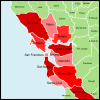The epidemiology and surveillance response to pandemic influenza A (H1N1) among local health departments in the San Francisco Bay Area
- PMID: 23530722
- PMCID: PMC3681650
- DOI: 10.1186/1471-2458-13-276
The epidemiology and surveillance response to pandemic influenza A (H1N1) among local health departments in the San Francisco Bay Area
Abstract
Background: Public health surveillance and epidemiologic investigations are critical public health functions for identifying threats to the health of a community. Very little is known about how these functions are conducted at the local level. The purpose of the Epidemiology Networks in Action (EpiNet) Study was to describe the epidemiology and surveillance response to the 2009 pandemic influenza A (H1N1) by city and county health departments in the San Francisco Bay Area in California. The study also documented lessons learned from the response in order to strengthen future public health preparedness and response planning efforts in the region.
Methods: In order to characterize the epidemiology and surveillance response, we conducted key informant interviews with public health professionals from twelve local health departments in the San Francisco Bay Area. In order to contextualize aspects of organizational response and performance, we recruited two types of key informants: public health professionals who were involved with the epidemiology and surveillance response for each jurisdiction, as well as the health officer or his/her designee responsible for H1N1 response activities. Information about the organization, data sources for situation awareness, decision-making, and issues related to surge capacity, continuity of operations, and sustainability were collected during the key informant interviews. Content and interpretive analyses were conducted using ATLAS.ti software.
Results: The study found that disease investigations were important in the first months of the pandemic, often requiring additional staff support and sometimes forcing other public health activities to be put on hold. We also found that while the Incident Command System (ICS) was used by all participating agencies to manage the response, the manner in which it was implemented and utilized varied. Each local health department (LHD) in the study collected epidemiologic data from a variety of sources, but only case reports (including hospitalized and fatal cases) and laboratory testing data were used by all organizations. While almost every LHD attempted to collect school absenteeism data, many respondents reported problems in collecting and analyzing these data. Laboratory capacity to test influenza specimens often aided an LHD's ability to conduct disease investigations and implement control measures, but the ability to test specimens varied across the region and even well-equipped laboratories exceeded their capacity. As a whole, the health jurisdictions in the region communicated regularly about key decision-making (continued on next page) (continued from previous page) related to the response, and prior regional collaboration on pandemic influenza planning helped to prepare the region for the novel H1N1 influenza pandemic. The study did find, however, that many respondents (including the majority of epidemiologists interviewed) desired an increase in regional communication about epidemiology and surveillance issues.
Conclusion: The study collected information about the epidemiology and surveillance response among LHDs in the San Francisco Bay Area that has implications for public health preparedness and emergency response training, public health best practices, regional public health collaboration, and a perceived need for information sharing.
Figures
Similar articles
-
Public health emergency preparedness: lessons learned about monitoring of interventions from the National Association of County and City Health Official's survey of nonpharmaceutical interventions for pandemic H1N1.J Public Health Manag Pract. 2013 Jan-Feb;19(1):70-6. doi: 10.1097/PHH.0b013e31824d4666. J Public Health Manag Pract. 2013. PMID: 23169406
-
Public health management of antiviral drugs during the 2009 H1N1 influenza pandemic: a survey of local health departments in California.BMC Public Health. 2012 Jan 25;12:82. doi: 10.1186/1471-2458-12-82. BMC Public Health. 2012. PMID: 22276659 Free PMC article.
-
Evaluation of the implementation of the H1N1 pandemic influenza vaccine in local health departments (LHDs) in North Carolina.Vaccine. 2011 May 23;29(23):3969-76. doi: 10.1016/j.vaccine.2011.03.085. Epub 2011 Apr 6. Vaccine. 2011. PMID: 21477677
-
Public Health Policy and Experience of the 2009 H1N1 Influenza Pandemic in Pune, India.Int J Health Policy Manag. 2018 Feb 1;7(2):154-166. doi: 10.15171/ijhpm.2017.54. Int J Health Policy Manag. 2018. PMID: 29524939 Free PMC article. Review.
-
Department of Defense influenza and other respiratory disease surveillance during the 2009 pandemic.BMC Public Health. 2011 Mar 4;11 Suppl 2(Suppl 2):S6. doi: 10.1186/1471-2458-11-S2-S6. BMC Public Health. 2011. PMID: 21388566 Free PMC article. Review.
Cited by
-
Community Mitigation Guidelines to Prevent Pandemic Influenza - United States, 2017.MMWR Recomm Rep. 2017 Apr 21;66(1):1-34. doi: 10.15585/mmwr.rr6601a1. MMWR Recomm Rep. 2017. PMID: 28426646 Free PMC article.
-
The epidemiology and surveillance workforce among local health departments in California: mutual aid and surge capacity for routine and emergency infectious disease situations.Public Health Rep. 2014;129 Suppl 4(Suppl 4):114-22. doi: 10.1177/00333549141296S415. Public Health Rep. 2014. PMID: 25355982 Free PMC article.
-
School-based surveillance of acute infectious disease in children: a systematic review.BMC Infect Dis. 2021 Aug 3;21(1):744. doi: 10.1186/s12879-021-06444-6. BMC Infect Dis. 2021. PMID: 34344304 Free PMC article.
-
Public health incident management: logistical and operational aspects of the 2009 initial outbreak of H1N1 influenza in Mexico.J Emerg Manag. 2015 Jan-Feb;13(1):71-7. doi: 10.5055/jem.2015.0219. J Emerg Manag. 2015. PMID: 25779901 Free PMC article.
References
-
- Centers for Disease Control and Prevention. Public health preparedness capabilities: National standards for state and local planning. Tech. rep., Centers for Disease Control and Prevention. 2011. [ http://www.cdc.gov/phpr/capabilities/]. [Originally posted March 21, 2011 and updated on July 22, 2011]
-
- Council of State and Territorial Epidemiologists. 2009 National assessment of epidemiology capacity. Findings and recommendations. Tech. rep., Council of State and Territorial Epidemiologists. 2009. [ http://www.cste.org]
Publication types
MeSH terms
Grants and funding
LinkOut - more resources
Full Text Sources
Other Literature Sources
Medical
Research Materials



